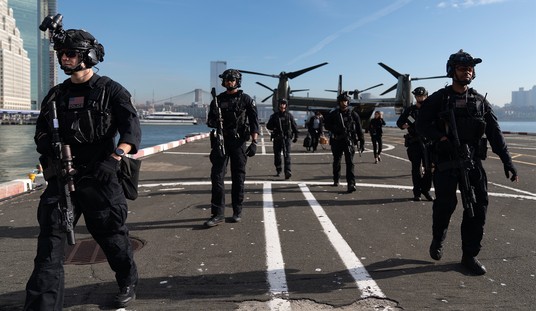President Biden claims the killing of al-Qaeda leader Ayman al-Zawahiri in Afghanistan in a CIA drone strike on July 31 validates his complete withdrawal of the remaining U.S. forces from that country last year. The president says we can rely instead on "over-the-horizon" counter-terrorism strikes.
Probably not.
Set aside for the moment the debacle the haphazard retreat ignited, necessitating the incomplete rescue of more than 100,000 Afghans, many of whom had aided U.S. forces. Discount, too, tens of billions of dollars worth of American military gear left for Afghanistan's returning Taliban Islamist rulers and other bad actors. Do so even if Russia, China, Iran and North Korea did not.
Consider instead what "over-the-horizon" counter-terrorism requires on the ground.
In July 2009, this writer participated as a civilian in the U.S. Army War College's strategic implementation seminar. This was a three-day session that helped cap a two-year master's degree in strategic implementation for several hundred regular Army Reserve and National Guard officers, mostly majors and lieutenant colonels. Primarily remote-learning, the program included two weeks of on-campus study each summer at the Carlisle, Pa. barracks.
Large lectures were leavened with break-out discussions, each with 15-20 officers and four or five civilians. One day the presiding colonel asked our group, "How many troops does the United States need in Afghanistan?" At the time, American forces in Afghanistan topped 50,000 because, even though post-Saddam Hussein Iraq remained Washington's priority, Taliban and al-Qaeda again were on the move.
Recommendations ranged from zero to 250,000. The officer advocating the former said the United States could suppress any future terrorism threats from "over-the-horizon," using on-the-ground intelligence to launch strikes from bases elsewhere in the greater Middle East or aircraft carriers on stand-off patrol.
Recommended
Other participants shot down that suggestion like a low-flying glider. They argued that U.S. intelligence operatives remaining in Afghanistan, and their networks, would need to be protected by a significant number of American forces.
Though President Obama wanted to withdraw all U.S. troops from Afghanistan, the deteriorating situation there dictated otherwise, so he surged an additional 33,000 GIs into the country. American troops in Afghanistan would peak at 100,000 the next year.
Still looking for the exit, if not in possession of an exit strategy, from 2010 to 2015, Obama cut U.S. forces by 90 percent. Nevertheless, he left 9,800 GIs to continue counter-terrorism missions and advise the chronically fragile, less than competent Kabul government on how to put down the Taliban.
Succeeding Obama, President Trump also wanted a complete pull-out from Afghanistan. But he heeded an imploring Pentagon, and 4,500 to 5,000 U.S. forces still were deployed there in late 2020.
Satellites, drones, electronic intercepts and other remote means provide reams of data. But human intelligence, including not only long-distance analyses of all that data but also eyewitness input involving but not limited to on-the-street surveillance and clandestine "black bag jobs," helps make sense of the data.
In May, the Defense Department's inspector general reported that "without a presence on the ground [in Afghanistan], the DoD relies on aviation assets to collect intelligence, surveil terrorist targets, and carry out airstrikes on terrorist targets."
The IG noted this means nations bordering Afghanistan must accept overflight agreements allowing U.S. surveillance aircraft to enter Afghan airspace. Pakistan is the only country currently permitting the United States to do so.
It's quite possible that the intelligence leading to Zawahiri's elimination derived in part from remnants of covert networks, including anti-Taliban Afghans, established before Biden's 2021 retreat. Given that the Taliban is back in charge and again close to al-Qaeda, in spite of its promises to Trump and Biden administration negotiators, it's less likely that more such actionable intelligence will be forthcoming.
The strike against Zawahiri has been the only publicly-known such over-the-horizon success since the American withdrawal. Meanwhile, the IG added, Afghanistan-based terrorists are regrouping. In addition to al-Qaeda itself is the worrisome Islamic State-Khorasan Province.
How many "boots on the ground" are enough for effective over-the-horizon counter-terrorism, especially in places run by terrorists? How many to protect undercover intelligence networks whose information gathering contributes to what superficially looks like solely long-distance elimination of enemy terrorist leaders like Zawahiri, his predecessor Osama bin Laden, Abu-Bakr al-Baghdadi of the Islamic State in Iraq and Syria and others of their ilk? And how many to disrupt attacks plotted by their lower profile but more numerous and more directly involved followers?
Fewer than 100,000? No doubt. But in view of the 900 GIs said to remain in Syria, without question, more than zero.
Eric Rozenman is the author of "From Elvis to Trump, Eyewitness to the Unraveling; Co-Starring Richard Nixon, Andy Warhol, Bill Clinton, the Supremes and Barack Obama!" recently published by Academica Press and communications consultant for the Washington, D.C.-based Jewish Policy Center. Any opinions expressed above are solely his own.

























Join the conversation as a VIP Member